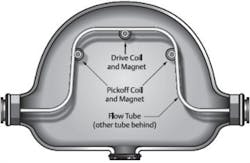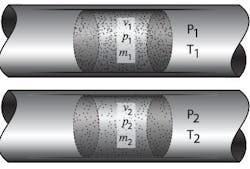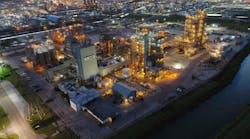When thinking of flow measurement, water is the first fluid that typically comes to mind. However, most flow applications are a bit more challenging than measuring clean water. Gas flow measurement, for example, is considerably more difficult due to the compressible nature of gas. Although changing pressure has little effect on the density of a non-compressible fluid like a liquid, pressure changes in a gas flow stream result in density changes as well. In addition, as the gas flows through the pipeline, the pressure naturally changes, resulting in different density values along the pipeline (Figure 1). This means that a cubic foot of gas at one point in the pipeline with a given set of temperature and pressure conditions doesn’t have the same number of molecules or same energy content as a cubic foot at some other set.
Figure 1. At two different pipeline conditions, the same volume of gas (V1=V2) can contain a different number of molecules. For example, when the pressure is higher and/or the temperature is lower (P1>P2 and/or T1
Reference Standards
As a result, standard or reference conditions were developed. This allowed for an “apples-to-apples” comparison of volumetric flowrates of gas at different conditions by correcting the volumetric reading from actual volume at the actual temperature and pressure conditions to a set of standard temperature and pressure conditions. However, there are multiple working definitions for these standard conditions, so it is still important to reference which set of “standard” conditions are being used. For example, the International Union of Pure and Applied Chemistry (IUPAC) established standard temperature and pressure as 273.15 K (0 C, 32 F) and 100 kPa-a (14.504 psia, 0.986 atm-a, 1 bar-a)1, while the Society of Petroleum Engineers (SPE) uses a reference temperature of 15 C and reference pressure of 100 kPa-a2, and the National Institute of Science and Technology (NIST) uses a reference temperature of 293.15 K (20 C, 68 F), and 101.325 kPa-a(1 atm-a)3 for gas.
Most gas flow measurements used today measure either the volume of the gas, velocity of the gas (and knowing the geometry of the flowmeter can readily output volume flow), or differential pressure as gas moves through a known reduced diameter (and, using Bernoulli’s equation, calculate the velocity of the gas, which is then output as volume flow using the known geometry) (Figure 2).
These are all very common methods of measurement and are widely accepted in industry. Most of these technologies are then combined with pressure and temperature compensation (e.g. PVTz corrections) in order to convert the actual volumetric flowrate to a standard volumetric flowrate (Figure 3). In some cases, the volumetric flowrate is combined with either a measured or calculated density (based on gas composition, pressure and temperature) and used to output mass flowrate of the gas.
Figure 2. Listing of some typical flowmeters with their primary output variable and the primary variable being measured.
Coriolis for Gas Flow
Although Coriolis flowmeters have been used very successfully in a wide variety of gas flow measurement applications for the past 20-plus years, and the American Gas Association (AGA) published the first Coriolis standard for custody transfer of natural gas approximately 10 years ago, this technology is oft overlooked for gas flow measurement applications. In fact, some of the properties mentioned earlier in this article that make gas flow measurement more complicated than liquid measurement for other technologies, have no effect on a Coriolis flowmeter.
Figure 3. Volumetric flowmeters require the knowledge of the operating density (which will depend on gas composition, pressure and temperature) in order to output standard or normal volume flow. For constant composition gases, this typically requires pressure and temperature measurement. For changing composition gases, this typically requires a gas chromatograph and pressure and temperature measurement, or a gas density meter.
A Coriolis mass flowmeter generally has one or two tubes (straight or bent) that are vibrated at their natural frequency (Figure 4). When there is no fluid flowing through the tube(s), the inlet and the outlet of the tube(s) are moving at the same time (Figure 5a). Sensing coils located on the inlet and outlet sections of the tube(s) oscillate and produce a sinusoidal electrical wave as the coil passes through a magnetic field (Figure 5b). When there is flow through the tube(s), because of the Coriolis effect, the gas causes the tube to twist (Figure 6a). The inlet of the tube and the outlet of the tube will no longer be moving at the same time. The time difference between the inlet and the outlet of the tube is proportional to the mass flow of the gas (Figure 6b). This is true for compressible and non-compressible fluids. Therefore, a Coriolis meter can measure mass flowrate for a gas application without needing to compensate for changes in the density resulting from pressure and temperature changes. Unlike thermal mass flowmeters, the Coriolis meter can measure the mass of a gas even if the composition is changing.
Figure 4. A typical curved tube Coriolis flowmeter has two parallel tubes that are vibrated at their natural frequency. All flow is split and flows through the bent tubes.
Coriolis Performance Advantages
There are a few advantages associated with eliminating the need for pressure and temperature compensation for fluid properties. The first is that eliminating external temperature and pressure reduces installation complexity in most cases (although some newer DP devices have these measurements fully integrated). In addition, reducing the number of measurement devices required reduces the potential leak points and potential maintenance issues. Finally, each measurement device will add to the overall uncertainty of the system and reduce overall accuracy.
Because the Coriolis flowmeter is not measuring velocity, a fully conditioned flow profile is not required. This further reduces the cost and complexity of installation and allows you to install the meter where it is most convenient.
Many users choose Coriolis meters for gas flow measurement where measurement accuracy is highly valued. Coriolis flowmeters are available on the market today with accuracies as good as +/-0.35 percent. Higher gas supply pressures help to maintain that high accuracy over a wider turndown than lower pressure applications. The best practice for installing Coriolis flowmeters for gas applications is to put the sensor upstream of any pressure regulator.
In addition, some Coriolis meters have meter verification capabilities that allow the user to check the calibration of the meter, as well as the health of the electronics. Results from the meter verification procedures can be used, according to AGA Report No. 11, to determine if and when field or laboratory flow tests should be completed. This can be a significant benefit for users since field flow tests can be difficult and expensive for gas applications.
Figure 5a. Looking at the Coriolis flowmeter from the top during no flow, the tubes are parallel to each other and the right and left sides move in unison.
Limitations of Coriolis
The initial capital cost of Coriolis meters is typically higher than other technologies and escalates rapidly with the size of the meter. When low value gases are being measured, the user may wish to consider less expensive measurement technology. However, it is important to not only consider the initial purchase price, but the overall cost of ownership. Even though Coriolis meters can be more expensive initially, other pieces of equipment are often eliminated (such as pressure and temperature measurement and flow computers for non-natural gas custody transfer). Installation costs and maintenance costs are also typically lower, which makes the overall cost of ownership less expensive than other technologies in many cases.
Coriolis meters are limited in line sizes to typically less than 16-inch lines. In the larger sizes, Coriolis meters can weigh over 1,000 pounds. Pressure loss through a Coriolis meter can be medium to high.
Figure 5b. During no flow, the inlet and the outlet side of the tube are moving together or in-phase.
Coriolis meters are physically larger than most other technologies, making installation difficult. This is especially true as the line size increases.
While Coriolis mass flowmeters work well for gas applications, typically other technologies such as DP flowmeters and Vortex flowmeters should be used for steam applications. Coriolis meters are also widely used for density measurement in liquid applications, but they typically should not be used for gas density measurement due to lack of resolution of the density measurement. Consequently, they should not be used for actual volumetric flow output. However, they can be used to output standard or normal volumetric flow using the following equation:
QStdVol = Qmass / ρref
Where:
QStdVol is Standard Volumetric Flow rate (e.g. SCFM or Nm3h)
Qmass is Mass Flow rate (measured by the Coriolis meter) (e.g. lb/min or kg/hr)
ρref is density of the gas at reference temperature and presure (independent of operating pressure and temperature).
Note that for a gas with a constant composition, the density of the gas at reference temperature and pressure (ρref) can be easily determined and entered into the Coriolis flowmeter as a constant (Figure 7). If the gas composition is changing, just like with any other flowmeter, additional measurement will be required.
Figure 6a. Looking at the Coriolis meter from the top while the fluid is flowing, there will be a twist in the tubes (shown exaggerated).
Other Gas Measurement Technologies
Many other technologies are being used today for gas flow measurement, including differential pressure, turbine meters, and ultrasonic meters.
Differential-pressure (DP) meters, such as orifice plates, annubars, Venturi tubes, and nozzles, have been used for over 100 years. AGA Report No. 3 provides guidelines for using DP meters for natural gas measurement.
Advantages of DP meters include:
> Simple to use
> No moving parts
> Capital cost can be low to medium
> Broad gas industry acceptance
> Not limited by line size
Disadvantages of DP meters include:
> Low accuracy and turndown compared to other meters
> Flow profile sensitive (requires straight runs and/or flow conditioners)
> Medium to high pressure loss
> Requires pressure and temperature compensation
Turbine meters are covered in AGA Report No. 7, and like DP meters have been around for well over 100 years.
Advantages of turbine meters include:
> Medium to high accuracy with medium turndown
> High tolerance to valve noise
> Capital costs are mid-range (typically more than DP, but less than others)
Disadvantages of turbine meters include:
> Moving parts that can wear over time and can be damaged with high flow rates
> Flow profile sensitive (requires straight runs and/or flow conditioners)
> Medium-to-high pressure loss
> Requires pressure and temperature compensation
Ultrasonic meters are also used for measuring gas flow. AGA Report No. 9 provides guidelines for using ultrasonic meters for natural gas applications.
Advantages of ultrasonic meters include:
> High accuracy and turndown
> Low pressure loss (although flow conditioners used with ultrasonic meters may increase this to medium pressure loss values)
> No moving parts
> No damage with high flow rates
> Multiple health diagnostics
> Available as clamp-on device (although accuracy degrades with this option)
Disadvantages of ultrasonic meters include:
> Medium to high capital cost
> Typically not available in very small line sizes
> Flow profile sensitive (requires straight runs and/or flow conditioners)
> Requires pressure and temperature compensation
Figure 6b. During flow, the inlet and outlet side of the tube will be out of phase. The time shift between the inlet and outlet is proportional to the mass flowrate.
A Good Fit for Gas Measurement
With no moving parts, gas mass flow accuracies as good as +/-0.25 percent of rate (more typically +/-0.35 percent to 0.5 percent), bi-directional flow capabilities, no need for gas calibration (manufacturer dependent), and no need for flow conditioning, Coriolis flowmeters are a good choice for many gas applications. Coriolis flowmeters can also typically handle dirty gases, as well as wet gases. And for a gas with known composition, the mass flow can easily be converted to standard or normal volumetric flowrate units to provide more familiar units.
Figure 7. Mass flowmeters require the knowledge of the density of the gas at reference conditions in order to output standard or normal volume flow. For constant composition gases, this will be a constant number. For changing composition gases, this number will vary and additional equipment (like a gas chromatograph or specific gravity meter) may be required.
There are approximately 100,000 Coriolis flowmeters installed on gas applications globally, ranging from custody transfer of gases such as hydrogen, ethylene, and natural gas to check meters to critical process feeds to gas phase reactors to combustion control.
Tonya Wyatt is the Process Gas Marketing Manager at Micro Motion, Inc., a Business Unit of Emerson Process Management. She is a member of AGA, AIChE and ACS and earned a bachelor’s degree in Chemical and Petroleum Refining Engineering from the Colorado School of Mines with a minor in Environmental Science and Engineering. She has been with Emerson since 2000 in a variety of roles, including applications, new product development, product management, and industry marketing. She worked for Eastman Chemical Company in the research and development group prior to joining Emerson. Ms. Wyatt can be reached at [email protected].
References
1. PAC, 1990, 62, 2167 (Glossary of atmospheric chemistry terms (Recommendations 1990)) on pages 2216-2217
2. Society of Petroleum Engineers, The SI Metric System of Units and SPE Metric Standard, June 1982.
(www.spe.org/authors/docs/metric_standard.pdf)
3. Johnson, Aaron, and Wright, John D., NIST Measurement Services: Gas Flowmeter Calibrations with the 26 m3 PVTt Standard, NIST Special Publication 1046, 2004.











